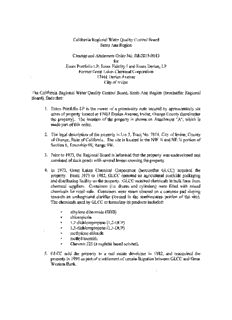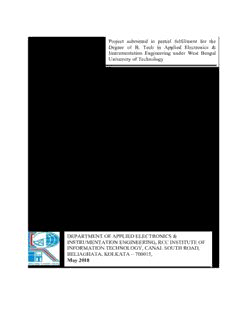
IOT BASED GARBAGE MONITORING USING ARDUINO By Md. Aasim Anwar PDF
Preview IOT BASED GARBAGE MONITORING USING ARDUINO By Md. Aasim Anwar
Project submitted in partial fulfillment for the Degree of B. Tech in Applied Electronics & Instrumentation Engineering under West Bengal University of Technology IOT BASED GARBAGE MONITORING USING ARDUINO By Md. Aasim Anwar (Roll No. 11705514020 ) Prateek Sarkar (Roll No. 11705514024 ) Rajeshwar Dutta (Roll No. 11705514025 ) Md. Sadik Mohammad Mollick (Roll No. 11705515055. ) Guide Name Dr. Srijan Bhattacharya DEPARTMENT OF APPLIED ELECTRONICS & INSTRUMENTATION ENGINEERING, RCC INSTITUTE OF INFORMATION TECHNOLOGY, CANAL SOUTH ROAD, BELIAGHATA, KOLKATA – 700015, May 2018 IOT BASED GARBAGE MONITORING SYSTEM USING ARDUINO ACKNOWLEDGEMENT It is a great privilege for us to express our profound gratitude to our respected teacher Dr. Srijan Bhattacharya, Applied Electronics &Instrumentation Engineering, RCC Institute of Information Technology, for his constant guidance, valuable suggestions, supervision and inspiration throughout the course work without which it would have been difficult to complete the work within scheduled time. We would like to express our gratitude towards Mr. Avishek Paul for his kind co-operation and encouragement which helped me in completion of this project. We are also indebted to the Head of the Department, Applied Electronics & Instrumentation Engineering, RCC Institute of Information Technology for permitting us to pursue the project. We would like to take this opportunity to thank all the respected teachers of this department for being a perennial source of inspiration and showing the right path at the time of necessity. Also, we would like to thank Mr. Debojit Mondal for his valuable contribution. ---------------------------------- Md. Aasim Anwar ---------------------------------- PrateekSarkar ---------------------------------- RajeshwarDutta ---------------------------------- Md. Sadik Mohammad Mollick 2 Dept. of AEIE, RCCIIT IOT BASED GARBAGE MONITORING SYSTEM USING ARDUINO CERTIFICATE OF APPROVAL The project report titled “IOT BASED GARBAGE MONITORING SYSTEM USING ARDUINO” prepared by Md. Aasim Anwar, Roll No: 11705514020, Prateek Sarkar, Roll No: 11705514024, Rajeshwar Dutta, Roll No: 11705514025and Md. Sadik Mohammad Mollick, Roll No:11705515055,is hereby approved and certified as a creditable study in technological subjects performed in a way sufficient for its acceptance for partial fulfilment of the degree for which it is submitted. It is to be understood that by this approval, the undersigned do not, necessarily endorse or approve any statement made, opinion expressed or conclusion drawn therein, but approve the project only for the purpose for which it is submitted. --------------------------------- ---------------------------------- [Supervisor] [Head of the Department] Applied Electronics & Instrumentation Engineering --------------------- [External ] 3 Dept. of AEIE, RCCIIT IOT BASED GARBAGE MONITORING SYSTEM USING ARDUINO RECOMMENDATION I hereby recommend that the project report titled “IOT BASED GARBAGE MONITORING USING ARDUINO” prepared by Md. Aasim Anwar, 11705514020, Prateek Sarkar, 11705514024, Rajeshwar Dutta, 11705514025, Md. Sadik Mohammed Mollick, Roll No:11705515055, be accepted in partial fulfillment of the requirement for the Degree of Bachelor of Technology in Applied Electronics & Instrumentation Engineering, RCC Institute of Information Technology. ......……………………………… ………………………………………. Supervisor Head of the Department, AEIE, RCCIIT ………………………………. External 4 Dept. of AEIE, RCCIIT IOT BASED GARBAGE MONITORING SYSTEM USING ARDUINO Chapter Name Page no Table of contents 5 Table of figures 5 List of tables 5 Introduction 6 Hardware Requirements 8 Design and Modelling 15 Implementation 16 System Testing 23 Conclusion 25 Experiment Results 26 References 27 List of Figures Page No 1. Flow Chart of Project 7 2. Arduino Uno Board 9 3. HC-SR04 Ultrasonic Sensor 11 4. GSM Module 13 5. DHT11 pin diagram 14 6. Pin out of NodeMCU 14 7. NodeMCU 15 8. Project diagram 16 9. Circuit diagram 16 10. Circuit diagram of NodeMCU 17 11. Screenshot of output 22 12. Actual circuit of NodeMCU 22 13. Output of sensor in serial monitor 26 14. Output as a Text Message 26 List of Tables Page No 1. Specification of Arduino 9 2. Pin number And their function 10 5 Dept. of AEIE, RCCIIT IOT BASED GARBAGE MONITORING SYSTEM USING ARDUINO 1. INTRODUCTION We are living in an age where tasks and systems are fusing together with the power of IOT to have a more efficient system of working and to execute jobs quickly! With all the power at our finger tips this is what we have come up with.The Internet of Things (IoT) shall be able to incorporate transparently and seamlessly a large number of different systems, while providing data for millions of people to use and capitalize. Building a general architecture for the IoT is hence a very complex task, mainly because of the extremely large variety of devices, link layer technologies, and services that may be involved in such a system. One of the main concerns with our environment has been solid waste management which impacts the health and environment of our society. The detection, monitoring and management of wastes is one of the primary problems of the present era. The traditional way of manually monitoring the wastes in waste bins is a cumbersome process and utilizes more human effort, time and cost which can easily be avoided with our present technologies. This is our solution, a method in which waste management is automated. This is our IoT Garbage Monitoring system, an innovative way that will help to keep the cities clean and healthy. 1.1 The problem Nowadays, there are tons of flats and apartments which have been built in the rapid urbanization area. This is due to high housing demands which have been drastically risen as a result of migration from villages to cities to find work. In order to accommodate the growing population in the urban area, the government has also constructed more apartment complexes. There are several issues faced by the residents of the flats. One of them is disposal of solid waste. Unlike private houses, the residents of all the apartments use a common dustbin, which tends to fill up very quickly. This overflowing of garbage is a sanitary issue which might cause diseases like cholera and dengue. Moreover it is a waste of fuel to travel around a complex or an area to find that some of the garbage are filled and some are not. Also, on rare days, problems might arise that there is so much garbage that the truck doesn’t have enough capacity. The idea struck us when we observed that the garbage truck use to go around the town to collect solid waste twice a day. Although this system was thorough it was very inefficient. For example let's say street A is a busy street and we see that the garbage fills up really fast whereas maybe street B even after 6 Dept. of AEIE, RCCIIT IOT BASED GARBAGE MONITORING SYSTEM USING ARDUINO two days the bin isn't even half full. This example is something that actually happens thus it lead us to the ''Eureka'' moment! Figure 1: Flow chart of project What our system does is it gives a real time indicator of the garbage level in a trashcan at any given time. Using that data we can then optimize waste collection routes and ultimately reduce fuel consumption. It allows trash collectors to plan their daily/weekly pick up schedule. An Ultrasonic Sensor is used for detecting whether the trash can is filled with garbage or not. Here Ultrasonic Sensor is installed at the top of Trash Can and will measure the distance of garbage from the top of Trash can and we can set a threshold value according to the size of trash can. If the distance will be less than this threshold value, means that the Trash can is full of garbage and we will print the message “Basket is Full” on the message and if the distance will be more than this threshold value, then we will print the distance remaining for the garbage vat to be full. 7 Dept. of AEIE, RCCIIT IOT BASED GARBAGE MONITORING SYSTEM USING ARDUINO 2. HARDWARE REQUIREMENTS We will need the following hardware to accomplish our project. 1. HC-SR04 ultrasonic sensor. 2. Arduino Uno. 3. GSM module 4. Connecting wires. 2.1 ARDUINO UNO Arduino is an open-source platform used for building electronics projects. Arduino consists of both a physical programmable circuit board (often referred to as a microcontroller) and a piece of software, or IDE (Integrated Development Environment) that runs on your computer, used to write and upload computer code to the physical board. The Arduino platform has become quite popular with people just starting out with electronics, and for good reason. Unlike most previous programmable circuit boards, the Arduino does not need a separate piece of hardware (called a programmer) in order to load new code onto the board – you can simply use a USB cable. Additionally, the Arduino IDE uses a simplified version of C++, making it easier to learn to program. Finally, Arduino provides a standard form factor that breaks out the functions of the micro-controller into a more accessible package. The Arduino is a microcontroller board based on the ATmega8. It has 14 digital -input/output pins (of which 6 can be used as PWM outputs), 6 analog inputs, a16 MHz ceramic resonator, a USB connection, a power jack, an ICSP header, and a reset button. It contains everything needed to support the microcontroller; simply connect it to a computer with a USB cable or power it with a AC- to-DC adapter or battery to get started .The Uno differs from all preceding boards in that it does not use the FTDI USB-to-serial driver chip. Instead, it features the Atmega16U2 (Atmega8U2 up to version R2) programmed as a USB-to-serial converter .Revision 2 of the Uno board has a resistor pulling the 8U2HWB line to ground, making it easier to put into DFU mode. Revision of the board has the following new features: Pin out: added SDA and SCL pins that are near to the AREF pin and two other new pins placed near to the RESET pin, the IOREF that allow the shields to adapt to the voltage 8 Dept. of AEIE, RCCIIT IOT BASED GARBAGE MONITORING SYSTEM USING ARDUINO provided from the board. In future, shields will be compatible with both the board that uses the AVR, which operates with 5V and with the Arduino Due that operates with 3.3V. The second one is a not connected pin that is reserved for future purposes. Stronger RESET circuit. AT mega 16U2 replace the 8U2. "Uno" means one in Italian and is named to mark the upcoming release of Arduino 1.0. The Uno and version 1.0 will be the reference versions of Arduino, moving forward. The Uno is the latest in a series of USB Arduino boards, and the reference model for the Arduino platform. Figure 2: ARDUINO UNO BOARD Parameters For Arduino UNODescription Microcontroller ATmega328 Operating Voltage 5V Input Voltage (recommended) 7-12V Input Voltage (limits) 6-20V Digital I/O Pins 14 Analog Input Pins 6 DC Current per I/O Pin 40 mA DC Current for 3.3V Pin 50 mA Flash Memory 32KB(ATmega328) of which 0.5KB used by bootloader SRAM 2 KB (ATmega328) EEPROM 1 KB (ATmega328) Clock Speed 16MHz 9 Dept. of AEIE, RCCIIT IOT BASED GARBAGE MONITORING SYSTEM USING ARDUINO Length 68.6 mm Width 53.4 mm Weight 53gm Table 1. Specifications of Arduino 2.2 HC-SR04 ULTRASONIC SENSOR. HC-SR04 is an ultrasonic sensor which is used for measuring the distance between the top of the lid to the top of the garbage. PIN NUMBER PIN NAME DESCRIPTION 1. VCC The Vcc pin powers the sensor, typically with +5V 2. Trigger Trigger pin is an Input pin. This pin has to be kept high for 10us to initialize measurement by sending US wave. 3. Echo Echo pin is an Output pin. This pin goes high for a period of time which will be equal to the time taken for the US wave to return back to the sensor. 4. GND This pin is connected to the Ground of the system. Table 2: Pin Number and Function of Ultrasonic sensor 2.2.2 HC-SR04 SENSOR FEATURES. Operating voltage: +5V Theoretical Measuring Distance: 2cm to 450cm Accuracy: 3mm Measuring angle covered: <15° Operating Current: <15ma Operating Frequency: 40Hz 10 Dept. of AEIE, RCCIIT
Description:The list of books you might like

Better Than the Movies

The 5 Second Rule: Transform your Life, Work, and Confidence with Everyday Courage

The Mountain Is You

Credence

Алгебра. 8 класс

DTIC ADA445281: Guide for Preparing Technical Information Reports of the Engineer Research and Development Center

Bon Dia Aruba (11 Januari 2006)

DTIC ADA545428: Department of State Contract to Study the Iraq Reconstruction Management System
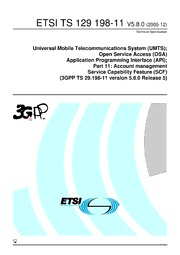
TS 129 198-11 - V5.8.0 - Universal Mobile Telecommunications System (UMTS); Open Service Access (OSA) Application Programming Interface (API); Part 11: Account management Service Capability Feature (SCF) (3GPP TS 29.198-11 version 5.8.0 Release 5)

Bölcsészettudományi Kar

Stefania ayangannae
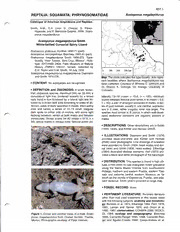
Sceloporus megalepidurus

Mice Other Poems by Gerald Bullett
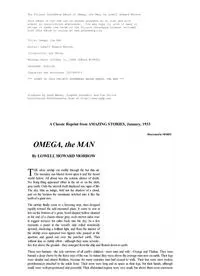
Omega the Man by Lowell Howard Morrow

DTIC ADA449316: How Deployments Affect Service Members
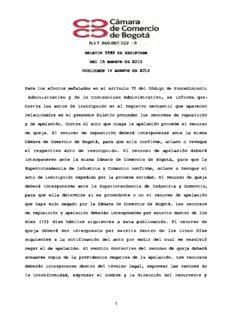
BOLETIN 3993 DE REGISTROS DEL 13 AGOSTO DE 2015 PUBLICADO 14 AGOSTO DE 2015 ...
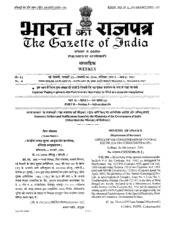
Union Government, Weekly, 2006-01-28, Part II-Section 3-Sub-Section(ii), Ref. 284-378

ERIC ED393806

Out Of Mulberry Street by Jacob A Riis
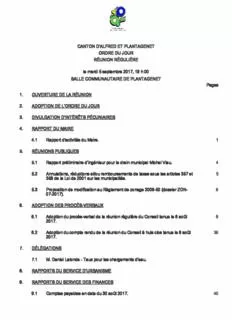
CANTON D'ALFRED ET PLANTAGENET ORDRE DU JOUR RÉUNION RÉGULIÈRE le mardi 5
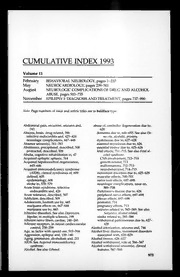
Neurologic Clinics 1993: Vol 11 Index

Microplastics: Analytical Challenges and Environmental Impacts

